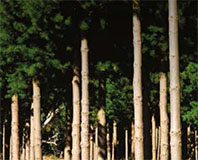ISO 14001
www.iso.org/iso/iso14000
ISO 14001 is an international standard that describes the specifications and requirements for an Environment Management System.
Plantation forestry | Plantation forestry pests | Forestry biosecurity practices | Hypothetical incursion | Plantation forestry quality assurance
The biosecurity practices described in this section of the site will assist you in achieving accreditation under Industry Best Management Practice (IBMP) and Quality Assurance (QA) schemes in relation to plantation forestry.
These schemes strengthen the forest industry’s potential to detect, control and eradicate plant pest or disease outbreaks rapidly, before extensive damage occurs. IBMP and QA schemes that cover some of the suggested biosecurity measures include:

www.iso.org/iso/iso14000
ISO 14001 is an international standard that describes the specifications and requirements for an Environment Management System.
www.forestrystandard.org.au
The Australian Forest Certification Scheme, which includes the Australian Standard for Sustainable Forest Management (SFM), sets out the requirements for forest owners seeking SFM certification. It includes requirements for the management of pests and diseases.
www.fscus.org
Forest Stewardship Council is another SFM certification scheme. It also includes requirements for the management of pests and diseases within forests/plantations.
Each state has recommended codes of practice. These codes of practice provide information on a range of forest activities. Links are provided below for further information.
New South Wales
Forestry Corporation, Publications, Manuals and Practice Codes
Northern Territory
NT Codes of Practice for Forestry Plantations
Queensland
Forestry Regulation and Legislation
South Australia
Guidelines for Plantation Forestry in South Australia 2009
Tasmania
Elements of the forest practices system
Victoria
Code of Practice for Timber Production
Western Australia
Code of Practice for Timber Plantations in WA